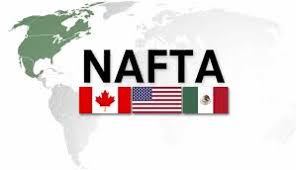A new NAFTA may be agreed on soon

ONE year ago, a member of President Donald Trump’s administration drafted a short executive order to withdraw America from the North American Free-Trade Agreement (NAFTA), a trade deal with Canada and Mexico. The obvious interpretation was that Mr Trump was irresponsibly bullying the Mexicans and Canadians into giving America better terms. A kinder view held that he was aiming at a domestic audience. Congress was dragging its feet at the time over the confirmation of Robert Lighthizer, the president’s chosen trade negotiator. Mr Trump’s threats were a way to kick it into action.
One year on, with Mr Lighthizer long since in place, America’s attitude to NAFTA seems no less hostile. Its threat of withdrawal still hangs over the talks, and in March Mr Trump waved the stick of tariffs on steel and aluminium in case a deal to revise NAFTA could not be reached by May 1st. This tough talk may yield an agreement within the next few weeks. Negotiators are working intensively in Washington, DC, with instructions to be available until May 4th. (Even after an agreement in principle is reached, it could take a little while longer to finalise all the details.)
Get our daily newsletter
Upgrade your inbox and get our Daily Dispatch and Editor’s Picks.
The details of any deal would bear the scars of hard negotiations. Mr Lighthizer has demanded that a new NAFTA expire automatically after five years and wants to weaken a clause that allows members to dispute emergency tariffs imposed by their partners. If his team prevails, the revised pact would be a step away from the integrated North American economy that the original deal was supposed to foster.
Mr Lighthizer’s team has also demanded that NAFTA be stripped of provisions that allow investors to sue governments if they are denied “fair and equitable treatment”. He reckons that claims against the American government should be tried in American courts, and that offering legal protection for American firms abroad underwrites the outsourcing of jobs. The Canadians and Mexicans, not to mention some senior Republicans, all disagree.
These proposals could yet be dropped. It seems more certain that a new deal will contain tighter “rules of origin” for cars, which specify how much North American content a car must have for it to qualify for zero tariffs. The Americans’ latest proposal is to raise the requirement from 62.5% to 75%. Although this is lower than their original demand of 85%, it could still cause disruption as car companies either reconfigure their supply chains or suck up non-NAFTA tariffs.
A related idea, to give carmakers credit towards the content requirement if they use parts made by workers earning more than a specified wage, would find support among those who worry that free-trade deals typically encourage a race to the bottom. But it would find opponents too, mostly from Mexicans who might see it as a way of favouring American and Canadian workers at their expense, and from the car companies forced to comply.
Yet the true costs of the Trump administration’s aggressive approach may show up as the three members try to move from a deal in principle to a deal in practice. Each member must have the agreement approved by its legislature. That will be more difficult if Mr Trump continues to treat NAFTA as a zero-sum pact (even if Mr Lighthizer recognises publicly that all three sides must gain).
That said, in Canada winning a vote should be fairly straightforward, given the governing party’s parliamentary majority. And although some have worried that Andrés Manuel López Obrador, the left-leaning front-runner in Mexico’s presidential race, will try to renegotiate if he wins, his pick for economy minister said on April 18th that Mr López Obrador would respect a deal struck before the election.
Oddly, America’s Congress may prove trickier. There is precious little chance of putting a deal before legislators before the mid-term elections on November 6th, and none of forcing them to vote on a deal in their final session if they are reluctant to do so. Securing votes in a lame-duck session after the election might require enticing members of Congress with special provisions to their liking, perhaps on intellectual property or agricultural markets. But those are precisely the sorts of provisions that could be ditched by negotiators in the interest of concluding a quick deal. Republicans will not like a deal that strips out the investor-state dispute-settlement rules, or has an expiry date.
Rather than courting centrist Democrats or Republicans of the sort who might have voted for the Trans-Pacific Partnership, a trade agreement from which Mr Trump withdrew as soon as he took office, Mr Lighthizer has been engaging more with left-wing Democrats and trade unions. This is a risky strategy, as these groups may still be unsatisfied by whatever labour standards Mr Lighthizer can negotiate and be wary of the political costs of associating with Mr Trump.
Mr Trump could revisit his threat of a year ago to withdraw from NAFTA, a step Mr Lighthizer reportedly favours. Presented with an alternative of no deal, that could force Congress to approve the new version. But Congress could also fight back, either by reversing any American tariff increases or by inserting “riders” in other bits of legislation to strip Mr Lighthizer’s department of funding to implement the NAFTA withdrawal. Whatever happens, agreement in principle is only the first part of the fight.
This article appeared in the Finance and economics section of the print edition under the headline “A deal undone”
